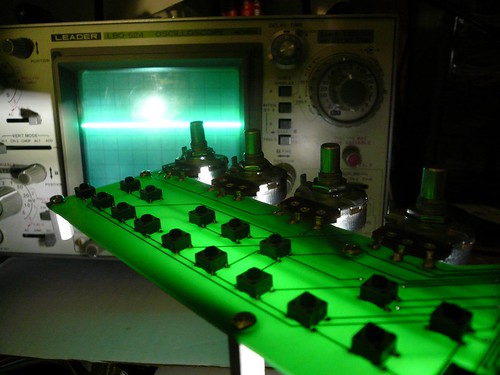
I received my Arduino Diecemila in the mail last week and have started to experiment with using it to synthesize audio and video. I’m not very experienced with programming microcontrollers, so I’ve been doing a lot of research to see what’s out there, and it’s greatly encouraging to see that people are taking this little kit in fun directions.
While I wasn’t able to find many “finished” projects, I did find a whole lot of ideas that deserve further exploration:
First up is a simple but effective “Arduino Theremin” from Alberto Bietti. Looks like this one uses an ultrasonic rangefinder rather than an RF field to effect pitch. The squelchy FM-like tone is a little screechy but could work well with a little bit of filtering:
Here’s a very nice MIDI Sequencer from beamercola, being played by IDM darling Tycho. The LEDs are a nice touch, and the stability as he ramps up the clock indicates a solid design. The end result is extremely musical and could stand on it’s own alongside some very pricey commercial counterparts:
Here’s a circuit-bend from octopussss using the Arduino to adjust the toy’s clock rate. Super freaky:
Sebastian Tomczak of little-scale has a very promising drum machine design. I’m sure he’s working on a newer version that doesn’t use those terrible DIP switches for controls:
Sebastian’s also got an amazing VGA synthesizer rigged up that is controlled by what looks like MIDI data synchronized to a beat made in Ableton Live. So awesome, and very portable. I could use one of these at my next live gig:
On a related note, here’s a project from iperry that uses the Arduino to separate incoming audio into frequency bands, then uses those signals to control the color/brightness of a few ambient orbs. Nicely done:
What’s great about these projects collectively is not their functionality, but the breadth of their intents. I’ve yet to see a fully functional polyphonic synth powered solely by Arduino, but I think we’re seeing the components of such a system coming together one by one. And because the Arduino is open-source and nearly all users share their data and experience, we’re only going to see more and better projects as time goes on. I think we’re just at the start of a long journey, one that will certainly delight and amaze as it unfolds.
Ed.: Terrific finds, Mike! But I’m surprised — you missed one of the biggest projects. It’s not polyphonic, mind, but it sounds fantastic. The Critter and Guitari folks, whom we already loved dearly for their video synths and organs and DIY video kit, have built a shield for the Arduino adding on synth capabilities. -PK
This is a board for making the Arduino into a portable stand alone music synthesizer. It plugs directly into the Arduino board and provides 25 multiplexed keys (2 full octaves), 4 pots, status LED, reset switch, digital to analog converter IC, and a RCA audio jack. The Arduino board with its powerful AVR processor is more than adequate for a wide range of sound synthesis techniques. We have experimented with additive / wave-table synthesis, frequency modulation, ring modulation, sampling, polyphony, various arpeggiators. The whole thing can be powered over the Arduino’s USB port for convenient experimenting.
Pocket Piano Arduino Shield Project Page
Here’s a hands-on demo, as captured by Make’s Collin Mel Cunningham :
My favorite project — the creators built a housing and fuzzy keyboard membrane out of felt, as pictured at the top of this story.
Felt Pocket Piano Enclosure How-To [Critter and Guitari]
Collin walks through the whole process of making the Pocket Piano project on MAKE:blog.
Build the Arduino Pocket Piano
Collin has also tried building his own synth project, as reported previously on MAKE.
I’m guessing that, with the Pocket Piano out for a few months, there are other projects we’re missing. So, fair readers, if you do have cool Arduino-based projects of any kind — or, for that matter, want to tell us that you really prefer a different kit or microcontroller platform — we’d love to hear from you! -PK


